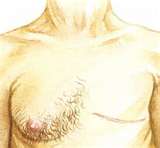Breast cancer can strike anyone, regardless of your age, gender, status and background, everyone is at risk of this deadly disease.
It is the second most common cancer in the world, eight to nine percent of women will develop breast cancer during their lifetime.
To women who has not yet attained menopausal age, the best thing to check breasts for cancer is shortly after menstrual period.
About eighty percent of breast tumors are found by women themselves. To examine themselves, women should lie their back and put one arm over or behind their head.
Using three or four fingers, they should examine their breasts working from the outside-in. A possible sign of breast cancer is a lump or thickening in the breast or a spot where the breast skin is drawn in redness and discharge from the nipple are other warning signs.
The doctor can first examine the breasts using ultrasound and if he or she suspects cancer, prescribed a mammogram.
Women over fifty of age should take advantage of any chance to have a mammogram because they comprise breast cancer risk group.
Early prevention is the key to reducing the risk of breast cancer. Examine your breasts for any lump and see your doctor regularly for clinical breast exam.
If you have just discovered a lump in your breast or armpit, don’t panic or worry too much either.
Take your time and be optimistic even so, remain calm. Most breast lumps are harmless, with up to three or four lumps that are suspected of being cancerous turn out to be benign cysts fibromas or lipomas. Any cancer lump if discovered early is highly treatable.
Men are not exempted from breast cancer too. While there is low incidence of breast cancer among males compared to women, the risks remains the same. Causes of men breast cancer are not completely known.
Nevertheless, the factors that might increase one’s risk are similar to both genders such as age ( fifty and above), radiation therapy to the chest at a young age, first degree relative who developed cancer at age forty or younger, post menopausal obesity, high estrogen level from fatty foods and a sedentary lifestyle.
That early detection and treatment are keys to increase the chances of survival of cancer patient. Exercising more than four hours a week reduces one’s risk by fifty percent.
A number of treatment methods can be administered on patients to cure breast cancer, limit the spread of the disease and provide relief of symptoms. Herewith, the following:
a) Neo-adjuvant therapy – a primary systematic therapy aims to reduce tumor size for breast conserving surgical treatment.
b) Surgery – Removing the tumor through a dumpectomy.
c) Adjuvant radiation therapy – High energy x rays to destroy cancer cells.
d) Hormonal therapy – Some breast cancers are dependent on estrogen (ER-positive). This therapy blocks the growth of ER positive tumors.
e) Chemotherapy – Use as a component of treatment in both early and advance disease settings. A number of chemo drugs are used alone of in combinations with other therapies which lessens symptoms associated with chemotherapy and can be taken orally in the patient’s convenience, usually at home.
One has to understand that breast cancer if discovered early is highly treatable and screening is a key ingredient to ensure proper diagnosis, treatment and cure of this dreaded disease.
